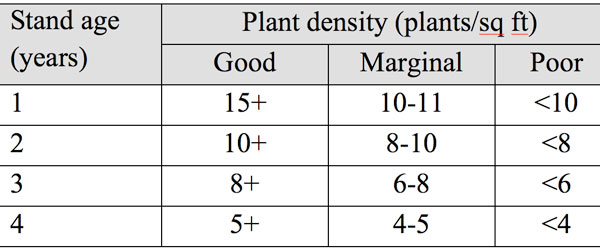Historically, alfalfa seed companies offered a limited number of variety options for growers. Because of breeding advances, growers have more options for their acres than ever before.
Growers should look at a number of factors when choosing a variety, including winterhardiness, yield potential, pest and disease resistance, forage quality, performance data and weed control needs.
Weed control options have expanded with the recent approval of Roundup Ready® alfalfa. Glyphosate-tolerant varieties offer growers the opportunity for weed-free, quality hay. To hear more about alfalfa with the Roundup Ready gene coming back on the market, click here.
While fall planting is most often the optimum time for planting alfalfa, spring planting is a viable option. As alfalfa begins to break dormancy this spring, growers should evaluate the stand density and yield potential.
When counting plants per square foot, growers should take a random one-foot square and count the number of plants (crowns) that are alive and healthy. Take four to five counts for every 10 acres.
Calculate the field average and use the table for determining quality.
If the stand is considered poor, spring planting might be the best choice. It is recommended to find another field for planting or wait 18 months due to autotoxicity concerns.
For information on the best alfalfa variety suited for your acres, contact your local seed sales professional.
Below are some management tips for planting this spring.
1. A firm seedbed is critical for successful alfalfa establishment.
2. Depth of planting is crucial for stand establishment.
• 1/4" to 1/2" deep on clay or loam soils
• 1/2" to 3/4" deep on sandy soils
3. Plant 12 to 18 pounds of pure live seed (PLS) per acre.
• PLS = % germination X % pure seed
4. Seeding 15 to 18 pounds per acre of product is often a good starting point for pure stands (clear seeding).
• 250,000 seeds per pound equals about 80 to 90 seeds per square foot
• Compensates for cloddy soil conditions in non-optimal seed beds
• Thick seedling stands compete better with weeds
12 pounds per acre may be adequate in optimal soil conditions or sandy soils, however:
• Minimal rates increase risk of non-uniform or spotty stands, which hurt production over the entire stand life
5. Plant April 1 to May 15 for spring seeding.
• Alfalfa seed will begin to germinate when soil temperatures are above 37ºF
• Fewer moisture stress and crusting problems in the spring FG
Robin Newell
Senior Forages Business Manager
Pioneer Hi-Bred
robin.newell@pioneer.com










